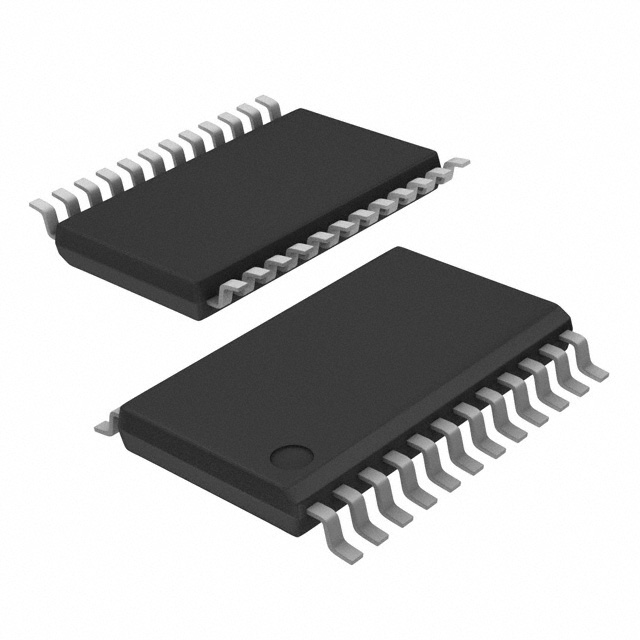Szczegóły produktu można znaleźć w specyfikacjach.

PCF8575CPWG4
Product Overview
- Category: Integrated Circuit
- Use: I/O Expander
- Characteristics: High-speed, 16-bit remote I/O expander for I2C-bus applications
- Package: TSSOP (Thin Shrink Small Outline Package)
- Essence: The PCF8575CPWG4 is a versatile I/O expander designed to provide additional input/output ports for microcontrollers or other devices.
- Packaging/Quantity: Available in reels of 2500 units
Specifications
- Supply Voltage: 2.3V to 5.5V
- I/O Ports: 16
- Interface: I2C-bus compatible
- Operating Temperature Range: -40°C to +85°C
- Speed: Up to 400 kHz
- Interrupt Output: Yes
Detailed Pin Configuration
The PCF8575CPWG4 has a total of 24 pins. The pin configuration is as follows:
- A0: Address Input Bit 0
- A1: Address Input Bit 1
- A2: Address Input Bit 2
- GND: Ground
- P7-P0: I/O Port 7 to I/O Port 0
- INT: Interrupt Output
- SDA: Serial Data Line
- SCL: Serial Clock Line
- VCC: Supply Voltage
Functional Features
- Provides 16-bit remote I/O expansion through the I2C-bus interface
- Can be used as inputs or outputs individually
- Supports interrupt output for efficient communication with the host device
- Low standby current consumption for power-saving applications
- Compatible with a wide range of microcontrollers and devices
Advantages and Disadvantages
Advantages
- Easy integration with existing systems through the I2C-bus interface
- Versatile and flexible I/O expansion capabilities
- Low power consumption in standby mode
- Wide operating voltage range allows compatibility with various devices
Disadvantages
- Limited number of I/O ports (16)
- Requires additional components for proper operation (microcontroller, I2C-bus interface)
Working Principles
The PCF8575CPWG4 operates as an I/O expander by communicating with a microcontroller or other devices through the I2C-bus interface. It provides 16 additional I/O ports that can be configured as inputs or outputs individually. The device is controlled by sending commands and data over the I2C-bus, allowing the host device to read or write to the I/O ports.
Detailed Application Field Plans
The PCF8575CPWG4 finds applications in various fields where additional I/O ports are required. Some potential application areas include:
- Industrial automation: Used to expand the number of I/O ports in control systems, allowing for efficient interfacing with sensors, actuators, and other devices.
- Home automation: Enables the connection of multiple input/output devices in smart home systems, such as controlling lights, appliances, and security systems.
- Automotive electronics: Provides extra I/O ports for automotive control units, facilitating the integration of various vehicle systems and peripherals.
- Internet of Things (IoT): Supports the expansion of I/O capabilities in IoT devices, enabling seamless connectivity and interaction with the physical world.
Detailed and Complete Alternative Models
- MCP23017: Similar I/O expander with 16-bit remote I/O and I2C-bus interface.
- MAX7313: I/O expander with 16-bit remote I/O, SPI interface, and interrupt output.
- PCA9555: 16-bit I/O expander with I2C-bus interface and interrupt capabilities.
These alternative models offer similar functionality and can be considered as alternatives to the PCF8575CPWG4 based on specific requirements and compatibility with existing systems.
Word count: 511 words
Wymień 10 typowych pytań i odpowiedzi związanych z zastosowaniem PCF8575CPWG4 w rozwiązaniach technicznych
Sure! Here are 10 common questions and answers related to the application of PCF8575CPWG4 in technical solutions:
Q: What is PCF8575CPWG4? A: PCF8575CPWG4 is an I/O expander integrated circuit (IC) that provides additional input/output ports for microcontrollers or other digital devices.
Q: How many I/O ports does PCF8575CPWG4 offer? A: PCF8575CPWG4 offers a total of 16 I/O ports, which can be configured as either inputs or outputs.
Q: What is the voltage range supported by PCF8575CPWG4? A: PCF8575CPWG4 supports a voltage range of 2.3V to 5.5V, making it compatible with a wide range of microcontrollers and digital devices.
Q: Can PCF8575CPWG4 handle both analog and digital signals? A: No, PCF8575CPWG4 is designed to handle only digital signals. It does not support analog signals.
Q: How can PCF8575CPWG4 be controlled by a microcontroller? A: PCF8575CPWG4 uses the I2C communication protocol to interface with a microcontroller. The microcontroller sends commands and data to control the I/O ports.
Q: Can PCF8575CPWG4 be used to drive high-power devices directly? A: No, PCF8575CPWG4 has limited current sourcing/sinking capabilities. It is recommended to use external drivers or relays for high-power devices.
Q: Is PCF8575CPWG4 suitable for applications requiring real-time response? A: PCF8575CPWG4 is not designed for real-time applications. It has a relatively slow response time due to the I2C communication protocol.
Q: Can multiple PCF8575CPWG4 ICs be used together in a single system? A: Yes, multiple PCF8575CPWG4 ICs can be connected on the same I2C bus, allowing for expansion of I/O ports.
Q: What are some common applications of PCF8575CPWG4? A: PCF8575CPWG4 is commonly used in applications such as keypad interfacing, LED matrix control, digital sensors, and general-purpose I/O expansion.
Q: Are there any limitations or considerations when using PCF8575CPWG4? A: Some considerations include the limited current capabilities, slower response time, and the need for pull-up resistors on the I2C lines. Additionally, proper voltage level shifting may be required when interfacing with devices operating at different voltage levels.
Please note that these answers are general and may vary depending on specific application requirements and circuit design considerations.

